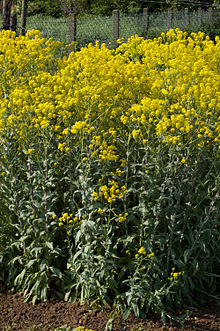Natural dyes
Natural dyes are organic dyes of vegetable or animal origin. Colloquially, naturally occurring inorganic pigments are sometimes referred to as natural dyes.
Vegetable natural dyes
According to August Seybold , plant dyes can be divided into according to their cytological occurrence
- plasmochromic plant dyes (localization in chromoplasts or chloroplasts and therefore hydrophobic ),
- chymochromic plant dyes (localization in the aqueous cell sap of the vacuole and therefore hydrophilic ) and
- membranochromic plant dyes (localization in the cell wall ).
The most important natural plant pigments are the green chlorophylls - magnesium complex pigments with a porphyrin structure . These are crucial for photosynthesis . The color of flowers and fruits is caused by the water-soluble anthocyanins and flavones . Like the anthocyanins, the fat-soluble carotenoids are also used as food coloring .
Significant plant dyes for dyeing textiles or other substrates are indigo , extracted from the indigo plant or woad , henna (also Lawson ) from the henna , Alizarin from the root of the madder , crocetin from saffron and brasilin from Redwood (also Basilholz ).
Natural animal dyes
The most important animal dyes are structurally related to the chlorophylls Häme z. B. the heme b as part of the blood pigment hemoglobin . The red iron-containing porphyrin complexes play a central role in the uptake of oxygen .
Important natural dyes of animal origin for dyeing applications are purple from the purple snail , and various red dyes from scale insects - for example, real carmine from cochineal , Kermes ( fake Carmine ) from various European and Asian scale insects and Lac Dye from the lac insect .
use
A wide variety of materials (textiles, wool, leather, hair, etc.) have been dyed with natural dyes for thousands of years, although with the development of synthetic dyes from the second half of the 19th century, this use has declined sharply. Some natural colors still play a role as approved food colors.
See also
literature
- Renate Kaiser-Alexnat: Coloring agents from nature. An overview with a review and perspectives . epubli GmbH, Berlin 2012, ISBN 978-3-8442-2095-7 . Brochure (PDF)
- Andrea Grotzky, Dörte Lösch: Dyeing with natural dyes. Institute Dr. Flad, Vocational College for Chemistry, Pharmacy, Biotechnology and Environment, 2003, accessed on November 26, 2018 .
- Gerhard Richter: Metabolic Physiology of Plants: Physiology and Biochemistry of Primary and Secondary Metabolism . 6th edition. Georg Thieme Verlag, Stuttgart, New York 1998, ISBN 978-3-13-442006-7 ( limited preview in Google book search).
Web links
Individual evidence
- ↑ Entry on natural dyes. In: Römpp Online . Georg Thieme Verlag, accessed on November 26, 2018.
- ↑ August Seybold: Investigations into the color change of flower petals, fruits and seed pods . In: Meeting reports of the Heidelberg Academy of Sciences . tape 1953/54 , no. 2 . Springer Verlag, Berlin, Heidelberg 1954, ISBN 978-3-662-28034-8 , doi : 10.1007 / 978-3-662-29542-7 ( limited preview in the Google book search).
- ^ Albert Gossauer: Structure and reactivity of biomolecules: An introduction to organic chemistry . Verlag Helvetica Chimica Acta, Zurich 2006, ISBN 978-3-906390-29-1 , p. 477 ( limited preview in Google Book search).
- ↑ Specifications of the permitted food additives


